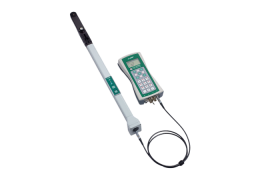The LAI-2200C is designed for low maintenance, and generally it should require little servicing beyond keeping it clean and replacing the batteries.
Control Unit
The control unit battery compartment is on the back of the instrument. To open the battery compartment, remove the two screws that secure the battery cover with a #1 cross-head (Philips) screwdriver. The control unit requires 4 “AA” batteries. Be sure to observe proper polarity when changing batteries. Replace the batteries and reattach the cover.
Optical Sensor
The optical sensor uses 2 “AA” batteries, which are in the handle of the optical sensor. To remove the optical sensor batteries, use a coin or large flat-tipped screwdriver to turn the battery cap counter clockwise about ¼ turn. When inserting new batteries, insert the negative (-) pole into the battery holder first. The positive (+) pole on the second battery makes contact with the black cap (part number 345-10735).
If the instrument is to be stored for a long period of time, remove the batteries to prevent damage that may result from battery leakage and corrosion.
Calibration
There are two parts to the factory calibration. One is done at a range of angles in collimated light, and is used to center the detector and verify the angular response. The other is done in isotropic conditions (an integrating sphere) and provides calibration factors that are used to match each ring’s output to each other, but not to any absolute standard. This inter-ring calibration has no effect on LAI determination, but would be important if you were to use the sensor to map angular distributions of diffuse radiation.
Recalibration of the optical sensor is not necessary, as long as the optics within the sensor remain in place. The detectors may have long-term electrical drift, but this will not affect LAI determinations.
Instructions for entering calibration multipliers are in Calibration and Match Values. The procedure for matching two sensors is separate from calibration and is described in Matching Sensors.
Cleaning
The optical sensor lens should be kept free of dust, dirt, and deposits when collecting data. To help keep the lens clean, leave the opaque lens cap in place when the instrument is not in use.
The front lens of the optical sensor can be cleaned with distilled water or the Lens Cleaning Kit included with the instrument.
Note: Be very careful not to scratch the MgF2 coating on the lens. Avoid cleaning the lens with paper products, and never wipe the lens while it is dry. Damage to the lens is not covered under the warranty.
The instrument display and keypads can be cleaned with a moistened non-abrasive cloth when necessary.
Storage
When storing the LAI-2200C for a long period of time, remove the “AA” batteries, replace the bulkhead connector caps, and attach the lens cap.
